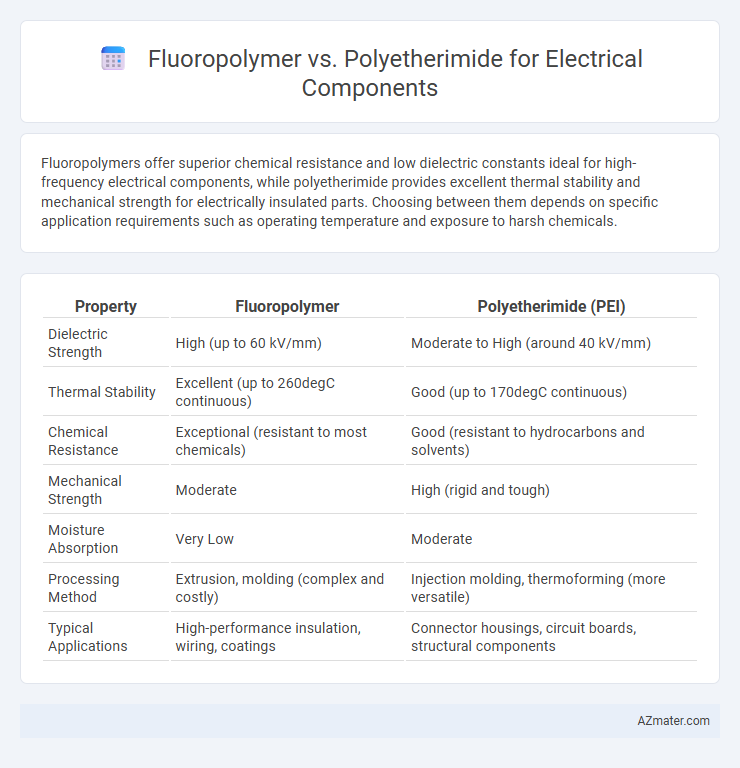Fluoropolymers offer superior chemical resistance and low dielectric constants ideal for high-frequency electrical components, while polyetherimide provides excellent thermal stability and mechanical strength for electrically insulated parts. Choosing between them depends on specific application requirements such as operating temperature and exposure to harsh chemicals.
Table of Comparison
| Property | Fluoropolymer | Polyetherimide (PEI) |
|---|---|---|
| Dielectric Strength | High (up to 60 kV/mm) | Moderate to High (around 40 kV/mm) |
| Thermal Stability | Excellent (up to 260degC continuous) | Good (up to 170degC continuous) |
| Chemical Resistance | Exceptional (resistant to most chemicals) | Good (resistant to hydrocarbons and solvents) |
| Mechanical Strength | Moderate | High (rigid and tough) |
| Moisture Absorption | Very Low | Moderate |
| Processing Method | Extrusion, molding (complex and costly) | Injection molding, thermoforming (more versatile) |
| Typical Applications | High-performance insulation, wiring, coatings | Connector housings, circuit boards, structural components |
Overview of Fluoropolymers and Polyetherimide
Fluoropolymers, such as PTFE and FEP, offer exceptional chemical resistance, low dielectric constant, and high thermal stability, making them ideal for insulating electrical components exposed to harsh environments. Polyetherimide (PEI) provides excellent mechanical strength, high glass transition temperatures around 217degC, and good dimensional stability, supporting reliable performance in high-temperature electrical applications. Both materials deliver critical electrical insulation properties, but fluoropolymers excel in chemical inertness and low surface energy, while polyetherimide balances thermal endurance with superior mechanical robustness.
Chemical Structure and Composition Comparison
Fluoropolymers such as PTFE are composed of carbon-fluorine bonds, providing exceptional chemical resistance and low dielectric constants, making them ideal for high-frequency electrical components. Polyetherimide (PEI) features an aromatic backbone with imide and ether linkages, offering high thermal stability and good dielectric strength but higher dielectric constant compared to fluoropolymers. The unique chemical composition of fluoropolymers yields superior hydrophobicity and electrical insulation, whereas PEI balances mechanical robustness and thermal performance for complex electrical applications.
Electrical Insulation Properties
Fluoropolymers exhibit superior electrical insulation properties due to their high dielectric strength, low dielectric constant, and excellent resistance to moisture and chemical degradation, making them ideal for high-performance electrical components. Polyetherimide (PEI) offers good dielectric properties combined with high thermal stability and mechanical strength, but its dielectric constant is generally higher than that of fluoropolymers, resulting in relatively lower insulation effectiveness in demanding environments. The choice between the two materials depends on the specific application requirements, including operating temperature, electrical stress, and environmental exposure.
Thermal Stability and Heat Resistance
Fluoropolymers exhibit superior thermal stability with continuous use temperatures often exceeding 200degC, making them ideal for high-heat environments in electrical components. Polyetherimide (PEI) offers excellent heat resistance up to approximately 170degC, providing strong mechanical properties and dimensional stability under moderate thermal stress. Choosing between fluoropolymer and polyetherimide depends on the specific thermal demands, with fluoropolymers preferred for extreme heat resistance and polyetherimide favored for a balance of thermal performance and structural integrity.
Mechanical Strength and Durability
Fluoropolymers exhibit exceptional chemical resistance and low friction characteristics, making them highly durable in harsh electrical environments, while their mechanical strength typically ranges from moderate to high depending on specific formulations. Polyetherimide (PEI) offers superior mechanical strength and dimensional stability at elevated temperatures, with tensile strengths often exceeding 100 MPa and excellent impact resistance, making it ideal for demanding electrical components. In applications requiring a balance of mechanical robustness and long-term durability under thermal stress, PEI generally outperforms fluoropolymers due to its higher modulus and thermal endurance.
Resistance to Chemicals and Environmental Factors
Fluoropolymers exhibit superior chemical resistance to aggressive solvents, acids, and bases, making them highly suitable for electrical components exposed to harsh environments. Polyetherimide offers good resistance to heat and moderate chemical exposure but is less effective against strong oxidizing agents and corrosive chemicals compared to fluoropolymers. Environmental factors such as UV radiation and moisture are better resisted by fluoropolymers, which maintain electrical insulation properties under extreme conditions, whereas polyetherimide may experience degradation over prolonged exposure.
Processing and Fabrication Methods
Fluoropolymers such as PTFE and FEP offer excellent chemical resistance and electrical insulation, but their high melting points and poor melt flow often require specialized sintering or paste extrusion processes for fabrication. Polyetherimide (PEI) features superior melt processability with injection molding and extrusion methods, enabling complex shapes and tighter tolerances in electrical components. Processing Fluoropolymers demands slower cooling and post-processing like machining or compression molding, while PEI supports faster cycle times and easier thermal bonding during fabrication.
Cost Analysis: Fluoropolymers vs. Polyetherimide
Fluoropolymers typically exhibit higher material and processing costs compared to polyetherimide, driven by their specialized chemical resistance and thermal stability properties. Polyetherimide offers a more cost-effective solution in electrical components due to its lower raw material price and easier manufacturability while still providing excellent electrical insulation and mechanical strength. Considering lifecycle expenses, fluoropolymers may justify their premium in high-performance or extreme environment applications, whereas polyetherimide is preferred for budget-sensitive projects requiring reliable electrical performance.
Typical Applications in Electrical Components
Fluoropolymers are widely used in electrical components requiring exceptional chemical resistance and high dielectric strength, such as insulating wires, cable jacketing, and circuit board coatings. Polyetherimide (PEI) finds typical applications in connectors, switches, and components subjected to high thermal stress due to its excellent mechanical properties and thermal stability. Both materials provide crucial performance benefits in electrical insulation, with fluoropolymers excelling in harsh chemical environments and PEI in high-temperature conditions.
Selection Criteria for Optimal Electrical Performance
Fluoropolymers offer exceptional dielectric strength, low dielectric constant, and superior chemical resistance, making them ideal for high-frequency electrical components requiring minimal signal loss and robust insulation. Polyetherimide (PEI) provides excellent thermal stability, high dielectric strength, and superior mechanical properties, suitable for components exposed to elevated temperatures and mechanical stress. Selection criteria for optimal electrical performance prioritize dielectric constant, thermal resistance, mechanical durability, and chemical inertness to ensure long-term reliability and efficiency in specific electrical applications.

Infographic: Fluoropolymer vs Polyetherimide for Electrical Component
 azmater.com
azmater.com